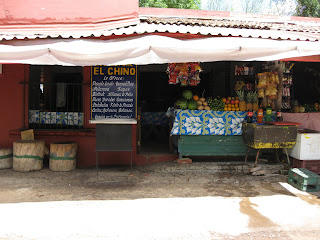This week’s theme is leisure and business,
with a little local history as a bonus.
You will have gathered from the previous
bulletins that Mexican towns are crowded, noisy, busy places. So, quiet spaces
for leisure are much sought after. When our son John visited us this week, we
asked for recommendations of things to do, and everybody recommended
Lake Camécuaro, a national park in the
adjacent municipality of Tangancícuaro. Buses leave every 15 minutes from the
Central de Autobuses and drop passengers, upon request, on the main road,
leaving passengers to walk 700 metres to the lake.
By 11am the park was already busy with
children splashing around in the shallower waters, family groups carrying
elaborate picnic supplies, including small gas burners and large cooking pots.
Other families were already paddling around the lake in brightly painted lanchas.
It is not hard to imagine the delight of young children (or in more remote
spots courting couples) in escaping from the urban hubbub to the rural hubbub
and cool shade and waters.
 |
| El Chino's restaurant |
You will also have gathered that commerce
is ever present in Mexico. Camécuaro is no exception. To the right a number of
stalls offer a wide variety of food offerings. Smaller-scale operators provided
grilled corn-on-the-cob and a variety of other snacks. To the left were the
sellers of flotation aids and other child-centred paraphernalia. As we left
after lunch, a candy floss seller was alighting from a taxi with a long pole
from which hung plastic bags of many-coloured floss. By lunch time a 10-piece
mariachi band was entertaining a particularly large family group.
 |
| A mariachi at Lake Camécuaro |
 |
| The creek at Camécuaro |
A friend at the Colegio had recommended the
last food stall on the right, known as El Chino. Despite
his nickname, El Chino
is a Mexican with curly (unusual for a Mexican) black hair. Although the
business carries his name, we discovered that his wife does the cooking and
collects the cash. As our friend recommended, we ordered mojarra adobada,
grilled marinated fish served with salad, beans, rice, prickly pear leaves, tortillas
and the obligatory salsa. All served at a lakeside table.
 |
| Mojarra adobada |
Camécuaro is a welcome respite from the
bustle of Zamora, which is above all a business town. And its business is
agriculture on an imposing scale. The original agricultural wealth was built on
lettuce, tomatoes and potatoes. The climate and abundant water enabled
production out of season. Then Chilean berry growers arrived, seeking extra
capacity, and American importers came seeking reliable supplies. The Americans
supply the plants and market the berries. The Mexican growers do the hard work
of growing under poly tunnels and picking. The Chileans provide the irrigation
technology. This is not a business for small peasant farmers, since it requires
substantial investment in plants, poly tunnels and irrigation. The berries are
shipped both fresh and frozen, so packing and refrigeration factories are
dotted around the edges of town. The road around Zamora offers an expansive
view of acres of poly tunnels, the urban sprawl driven by an increasing population,
all dominated by the bulk of the Sanctuary of our Lady of Guadalupe, and ringed
by green hills.
 |
| Cattle ranching in Zamora's hills |
In the hills around the valley are the
cattle farms. As milk prices have fallen cattle farmers have turned
increasingly to raising cattle for beef. The market is in the populous state of
Mexico, around the capital, where the demand for barbecue meat is enormous.
Occasionally, as you travel round the
valley you see smoke rising from the hills. This is a sure sign that a
slash-and-burn peasant farmer is clearing a small plot of land to grow maize.
This was the way of agriculture in Mexico for centuries, but in the modern
republic it is the sign of poverty and marginalization.
Finally, to return to President Lázaro
Cárdenas. Tata (“father”) Lázaro, as he was known, was the last
president who
had fought in the Mexican Revolution of 1910-1920 which formed the modern
Mexican republic. He was born in Jiquilpan, not far from Zamora, in 1895, and
was governor of his home state from 1928-1930. As president, he distributed
land to Mexico’s impoverished peasant villages, promoted education and public
libraries, even in remote towns. He is most famous for nationalizing the oil
industry, then dominated by British and American companies in 1938 (the 80th
anniversary was marked this month). Nationalization has been reversed by
opening the oil and gas market to transnational companies in the current
administration of President Enrique Peña Nieto.
 |
| President Lázaro Cárdenas del Río |
Lázaro’s son, Cuauhtémoc (named after the
last Aztec emperor, tortured and murdered by the Spanish conquerors), was in
turn governor of Michoacán, and held several other official positions within
the regime managed by the PRI (Institutional Revolutionary Party). He broke
with the PRI and ran for President in 1988. It is generally considered that he
won the election but that the PRI rigged the result to prevent his victory. The
ruling party’s blatant theft of the election caused a political shock that
undermined the PRI’s grip on power. In 2000, Vicente Fox of the opposition PAN
(National Action Party) became the first non-PRI candidate elected in more than
seven decades. Cuauhtémoc ran for president subsequently but was not able to
repeat his success of 1988. Cuauhtémoc’s son, Lázaro has, in turn, been
governor of Michoacán and held other elected offices.
The preservation of Camécuaro is, then, one
of the legacies of an exceptionally powerful Michoacán family.


No comments:
Post a Comment